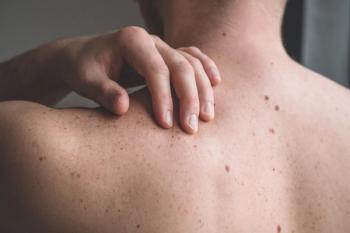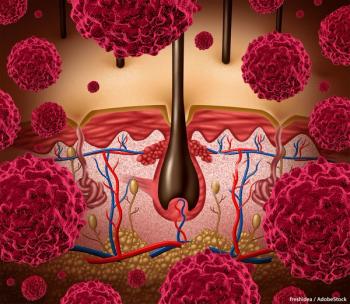
Strong Sunburns in Youth May Increase Melanoma Risk for White Women
The results of a prospective study showed that the risk of developing melanoma is higher for white women with a history of strong sun exposure during childhood and adolescence, rather than adulthood.
The results of a prospective study showed that the risk of developing melanoma is higher for white women with a history of strong sun exposure during childhood and adolescence, rather than adulthood. For nonmelanoma skin cancers-basal cell carcinoma (BCC) and squamous cell carcinoma (SCC)-exposure during both childhood and adulthood appear to be important. The study followed 108,916 women in the United States as part of the Nurses’ Health Study II and was
Women who had at least five strong sunburns accompanied by blistering between the ages of 15 and 20 had a 68% increased relative risk for nonmelanoma skin cancers and an 80% increased relative risk for melanoma. During adulthood (past the age of 20), cumulative exposure to high amounts of ultraviolet (UV) radiation had different effects on skin cancer risk. The women with the highest cumulative exposure to UV radiation during adulthood had the same risk of melanoma as women with the lowest cumulative UV exposure (P = .38). But, the women with the highest cumulative exposure to UV radiation did have a 2.4- to 2.5-fold higher risk of nonmelanoma skin cancers compared with women who had the lowest cumulative UV exposure (P < .0001 and P = .009 for BCC and SCC, respectively).
The study followed nurses, who were all between the ages of 25 and 42, for approximately 20 years, from 1989 to 2009. The women filled out a medical and sun exposure questionnaire at the time of enrollment and updated their health records every 2 years, which included family history, use of tanning beds, sun exposure, smoking and alcohol consumption, and body mass index. The study took into account the sun exposure in different US geographies in order to calculate the cumulative UV exposure per participant.
Among the study participants, 779 were diagnosed with melanoma (including 445 with invasive disease), 6,955 with BCC, and 880 with SCC during the study period. Twenty-four percent of the women said that they had painful blistering sunburns prior to age 20, and about 24% had a history of using tanning beds.
Family history was a significant risk factor for melanoma. For BCC, the number of blistering sunburns between the ages of 15 and 20 years was a risk factor, while sunburn reaction during childhood and adolescence was an additional risk factor for SCC. Sunburn reaction in childhood and adolescence, red hair, and the number of blistering sunburns between the ages of 15 and 20 years were all factors able to predict risk of all three types of skin cancer.
The finding that cumulative UV exposure correlates with risk of nonmelanoma skin cancers is consistent with previous studies, according to Abrar A. Qureshi, MD, MPH, professor and chair of the department of dermatology at Warren Alpert Medical School of Brown University, and coauthors.
Whether the findings here can be extended to women of other ethnicities, as well as men, is not clear.
“Pattern of sun exposure was not uniformly associated with the risk for all three main skin cancers we see in the United States, suggesting that there are some differences in the pathophysiology of these skin cancers,” said Qureshi in a released statement.
Newsletter
Stay up to date on recent advances in the multidisciplinary approach to cancer.

















































































